A History of the County of Bedford: Volume 3. Originally published by Victoria County History, London, 1912.
This free content was digitised by double rekeying. All rights reserved.
'Parishes: Marston Moretaine', in A History of the County of Bedford: Volume 3, ed. William Page (London, 1912), British History Online https://prod.british-history.ac.uk/vch/beds/vol3/pp307-313 [accessed 19 April 2025].
'Parishes: Marston Moretaine', in A History of the County of Bedford: Volume 3. Edited by William Page (London, 1912), British History Online, accessed April 19, 2025, https://prod.british-history.ac.uk/vch/beds/vol3/pp307-313.
"Parishes: Marston Moretaine". A History of the County of Bedford: Volume 3. Ed. William Page (London, 1912), British History Online. Web. 19 April 2025. https://prod.british-history.ac.uk/vch/beds/vol3/pp307-313.
In this section
MARSTON MORETAINE
Mercstun (x cent.); Merstone (xi cent.); Mershtone (xiv cent.); Merstone Morteyne (xv cent.).
The acreage of this parish is larger than that of most in Bedfordshire, being 4,290 acres, of which 1,619¼ acres are arable, 2,185½ permanent grass and 144¼ woods. (fn. 1) The soil and subsoil are clay, which in the hamlet of Caulcott is employed in the manufacture of bricks.
The greater part of the parish is well below 200 ft. and in the extreme east barely rises above 130 ft. The village of Marston is placed on level ground 136 ft. above ordnance datum, but in the north-west the land rises considerably to a ridge over 340 ft. on which are Pinchgut Farm and Riddises Spinney. The land is very flat and uninteresting and mostly given up to pasture, though wheat, barley and beans are grown. The farms are numerous and often mark the sites of ancient manors. Among the more characteristic names are Manor, Moat, Beaucroft, Marston Park and Hungerhill. The only considerable piece of woodland in the parish is Marston Thrift, about 12 acres in extent, in the north-west.
The country is watered by a small tributary of the River Ouse, but the water supply for drinking purposes is a difficult problem. With the exception of the rectory and Moat Farm belonging to the Duke of Bedford, which draw a good and plentiful supply from a spring rising in Lidlington, it is obtained from surface wells.
The population is scattered, only a small portion residing in Marston Moretaine itself, the rest being distributed among the various hamlets. Of these, Caulcott with its brick kilns, Lower Shelton with its Methodist chapel, Upper Shelton and part of Wootton Green lie to the north. On the west are Roxhill and Wood End, while eastward near Millbrook station on the Bedford branch of the London and North-Western railway, which runs through this parish, is the small group of houses called Marston Pillinge. In the extreme south of the parish is Heydon Hill, used as a rifle butt, the range being 800 yds. long.
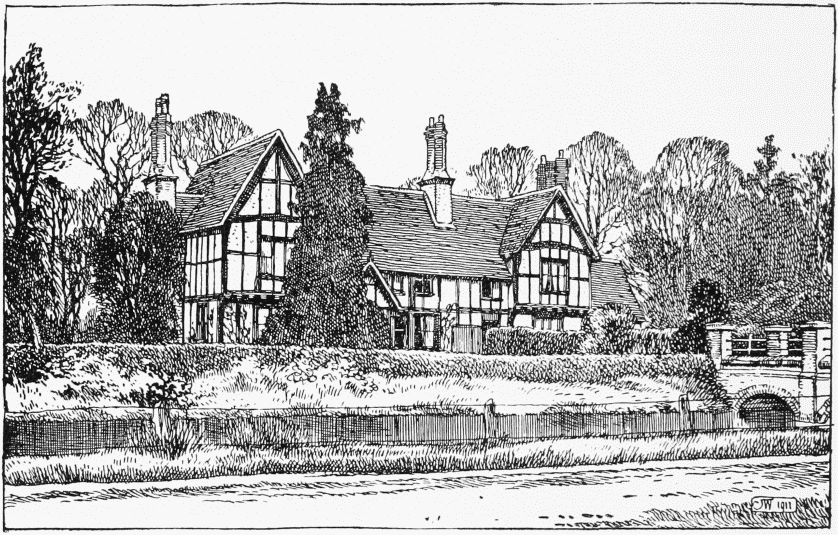
The Moat Farm, Marston Moretaine
Marston itself is a small modern village, in which the principal buildings are the church, schools, Baptist and Wesleyan chapels. It is situated north of the church along the road from Kempston to Husborne Crawley. The disturbed state of the ground to the south of the church suggests the site of the former village, a theory supported by the fact that the painting of St. Christopher on the wall of the north aisle could only be seen immediately upon entering the church through the south porch, then no doubt the principal entrance. The churchyard was enlarged by 25 p. in 1873, and again in 1899 by 2 r. 20 p., which included the site of a moated farm-house to the west of the church. The rectory stands to the north-west of the church and is of no great interest, but in the well-wooded grounds are a large granary and a square pigeon-house, both built of brick and having tile roofs. Opposite the rectory grounds on the west side of the Husborne Crawley road is the ancient manor-house, built of half-timber and brickwork, entirely surrounded by a deep moat still holding plenty of water. Accurate measurements show that this moat is 250 ft. on two sides by 300 ft. on the other two, the width of the trench, which is crossed by a foot-bridge, being between 50 ft. and 60 ft. Only the west front of the manor-house, which is a beautiful specimen of early 16th-century work, remains. The building was carefully and substantially restored and the interior modernized by the Duke of Bedford in 1880, when it was converted into the farm-house of the Moat Farm. This manor-house had been the residence of the Snagge family from 1562 to 1712, when Edward Snagge, lord of the manor, moved to a larger house which he built on higher ground a mile to the south-west. This latter house was pulled down by the Duke of Bedford in 1879. The site may still be traced in a field on Marston Park Farm.
In a field to the south of the village on the east side of the Woburn road is a stone connected with a local tradition of a visit of the Devil. The popular story is that a former owner of the field in which the stone is situated was playing at 'jumps,' probably another name for leap-frog, on the Sabbath, when the Devil took a leap from the church tower and, alighting on the stone, jumped with the offending party into eternity. The incident is perpetuated by the name of the inn near the stone, which is called 'The Jumps.'
A lace class was started here about eighteen months ago, and is now held in the school after school hours.
Part of the parish was inclosed in 1796. (fn. 2)
MANORS
A reference in 969 to the boundary of the men of Marston (Mercstuninga gemœre) is the first evidence of the existence of the village. (fn. 3) At the time of the Domesday Survey the overlordship of MARSTON MANOR was with Nigel de Albini, (fn. 4) whose family became the barons of Cainhoe. Thus the overlordship follows the descent of the barony (fn. 5) (q.v.). In 1086 Erfast was holding in Marston a manor of 8 hides and 1 virgate valued at £7. (fn. 6) The next tenant of the Albini family that can be found is Robert de Wotton, who held it in 1282–3, together with his wife Constance. (fn. 7) This Constance appears to have married for her second husband John de Morteyn. (fn. 8) In 1284 the same Constance de Morteyn held one and a half knights' fees in Marston. (fn. 9) By 1308 John de Morteyn was holding the manor, (fn. 10) and he was still holding eight years later. (fn. 11) Another John, probably the son of the last, was seised of it in 1328, (fn. 12) and continued to hold for nearly twenty years. (fn. 13) In 1350 his son Edmund was lord of Marston. (fn. 14) In 1366 Sir John de Morteyn had succeeded to the property, (fn. 15) upon the death of Edmund in that year. (fn. 16) The manor was at this date worth £20. (fn. 17) In 1380–1 Sir John died, (fn. 18) leaving his wife Elizabeth the profits of the manor. (fn. 19) Previous to his death, however, he had enfeoffed Sir Thomas Reynes, (fn. 20) but the latter granted the property to Elizabeth for life, (fn. 21) with remainder to Sir John de Morteyn with reversion in default to Richard Reynes and the heirs male of his body. John de Morteyn died without issue. (fn. 22) Richard Reynes died in 1420, (fn. 23) eight years before Elizabeth de Morteyn. Upon her death, therefore, Thomas the son of Richard Reynes, who had died in 1420, inherited the property. (fn. 24) He was succeeded by his son Thomas, (fn. 25) who was lord of Marston in 1451, (fn. 26) and he again by John Reynes, (fn. 27) whose daughter Elizabeth married Richard Decons. (fn. 28) The latter died in 1521, (fn. 29) and Thomas his son inherited the manor and held it till his death in 1550. (fn. 30) The manor was then inherited by his son and namesake, who died ten years later. (fn. 31) By the marriage of Elizabeth co-heir of Thomas Decons with Thomas Snagge in 1562 (fn. 32) the property passed into the hands of the latter's family. (fn. 33) He died seised of it in 1594, (fn. 34) when his son Sir Thomas inherited the property. (fn. 35) The latter was M.P. for Bedfordshire in 1586 and sheriff of the county in 1607. (fn. 36) Sir Thomas held the manor for thirty-two years, (fn. 37) and on his death in 1626 (fn. 38) it passed to his eldest son Thomas, who died in 1642. (fn. 39) The latter's eldest son Thomas was then seised of the manor till 1675. (fn. 40) He was the second member of the family to be made sheriff of the county, a post which he held in 1665. (fn. 41) He died in 1675, (fn. 42) and his sons Thomas and Edward successively inherited. (fn. 43) The latter was succeeded by his only son Edward in 1715, (fn. 44) who suffered a recovery of the manor in 1723, (fn. 45) and made good his claim to it in 1737. (fn. 46) He died two years later. (fn. 47) His father had been Sheriff of Bedfordshire in 1705 and his grandfather in 1678. (fn. 48) Lysons says that at about this date the Snagges sold to Sarah Duchess of Marlborough, and that she left the property to her grandson the Hon. John Spencer. (fn. 49) The statement is confirmed by the fact that John, who had become Earl Spencer, suffered a recovery of the manor in 1779. (fn. 50) The Spencers continued to hold till 1811, (fn. 51) after which the manor passed to the Alington family, being bought from Mr. Julius Alington of Little Barford in 1873 by the Duke of Bedford. (fn. 52)
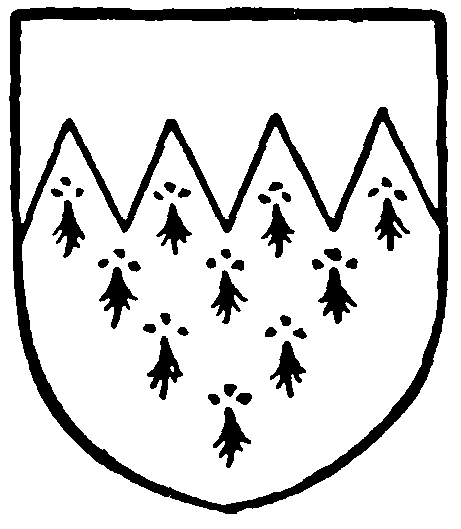
Morteyn. Ermine a chief indented gules.
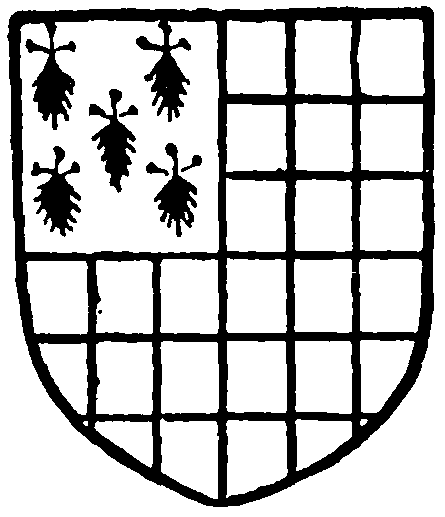
Reynes. Checky or and gules a quarter ermine.

Decons. Or a cheveron gules fretty or between three roses azure with stalks and leaves vert.
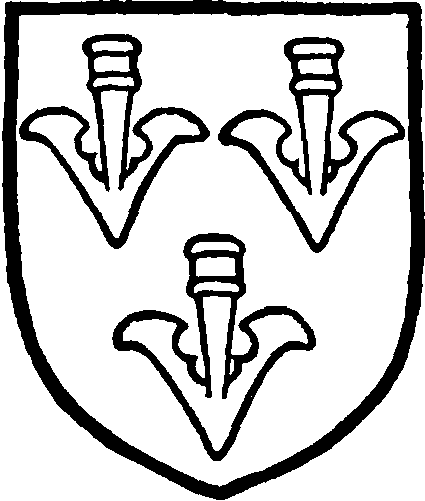
Snagge. Argent three pheons sable.
A second property within this parish is that of WROXHILL or ROXHILL MANOR. In 1086 it was held of Walter Giffard as 2 hides less half a virgate, (fn. 53) and the overlordship passed to the Earls of Oxford (heirs of the Bolebecs) some time in the 14th century, of whom it continued to be held as of their manor of Whitchurch (co. Bucks.) till the 16th century. (fn. 54)
From a later document it can be seen that the manor which Hugh de Bolebec held in 1086 (fn. 55) was ultimately held by three families. (fn. 56) The first of these appears in 1202–3, when Nigel de Merston was seised of 1 virgate of land in Marston. (fn. 57) John de Merston held in 1212–13, (fn. 58) Ralf in 1231–2, (fn. 59) and Richard his son in 1305–6. (fn. 60) The property was next held by John de Merston in 1310–11, (fn. 61) and one of the same name was still seised of it in 1346. (fn. 62)
From 1286 onwards a second interest is found in this estate. At that date Matilda wife of Richard de Argentein alienated by fine one quarter of a knight's fee to John Harmer. (fn. 63) In 1306 John son of John Harmer owned rents and lands in this parish, (fn. 64) and in 1346 one of the same name was holding by knight's service in Wroxhill together with John de Merston (whose descent has been traced above), Isabel Weedon (whose family had owned in Wroxhill certainly since 1233 (fn. 65) ) and Bernard de Willy, whose name is here mentioned for the first time. (fn. 66) This fee was in the possession of Bernard Saunderton in 1428, (fn. 67) who was succeeded by William Saunderton, who held Wroxhill Manor, here definitely so called, in 1459. (fn. 68) Before the end of the century Sir John Catesby was seised of the manor, (fn. 69) and was succeeded by his son Sir Humphrey Catesby, who died in 1504. (fn. 70) The manor at this time was worth more than 10 marks. (fn. 71) Sir Humphrey's younger son Thomas inherited this manor under his father's will, but he died in 1530 without male heirs, (fn. 72) and it passed to Anthony Catesby his elder brother. (fn. 73) Thomas Catesby was in possession in 1573, (fn. 74) and held it till his death in 1592, when George his son and heir inherited the property. (fn. 75) George and Bridget his wife with Clifton Catesby, doubtless their son, were holding the manor in 1636, (fn. 76) but about this time the Catesbys sold their estates and left the county. (fn. 77) It is probable that they sold them to the Playdells. William Playdell held the manor in 1652, (fn. 78) being described in the parish books of the time as 'a Londiner.' (fn. 79) By 1728 the manor had come into the possession of the family of Reddall. In this year Thomas Reddall was seised of it, (fn. 80) and in 1751 it had passed to Ambrose Reddall. (fn. 81) By 1800 James Bayly owned the manor, (fn. 82) and it was still his property ten years later. (fn. 83) Roxhill Farm is the only trace of its existence at the present time, and is in the tenancy of Mathew Folwell Bliss.
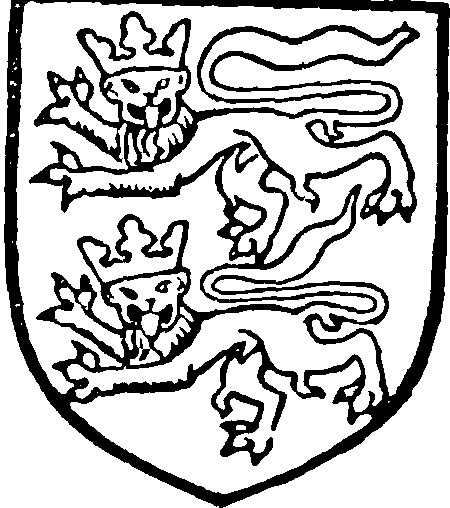
Catesby. Argent two leopards sable with golden crowns.
Another manor within this parish is that of PILLAGE or PELING. The first mention of it found is in 1443, when it belonged to Sir John Cornwall, (fn. 84) who owned Milbrook Manor (q.v.), and followed the same descent until the death of Sir Henry Grey in 1562. (fn. 85) Two years afterwards it passed to Sir Robert Dudley, (fn. 86) to whom it was probably sold. (fn. 87) Then for a period of one hundred years (1568–1669) the family of Saunders were seised of the manor, John holding it in 1568, (fn. 88) Richard in 1635 (fn. 89) and Sir John his son in 1669. (fn. 90) About this time the family sold their estates, (fn. 91) probably to Nathaniel Ryder, into whose possession a moiety of the manor had come by 1701, (fn. 92) and who then conveyed it to Robert Avenay. (fn. 93) The latter held it in the next year, (fn. 94) and conveyed it to Michael Arnold, who held it till 1704. (fn. 95) By 1769 the whole manor had come into the possession of John Fitz Patrick Earl of Upper Ossory (in the peerage of Ireland), (fn. 96) who was M.P. for Bedfordshire in 1767 and afterwards created Baron Upper Ossory of Ampthill (in the peerage of the United Kingdom). (fn. 97) The manor appears to have passed to Lord Ashburnham, from whose devisees it was purchased in 1843 by the Duke of Bedford, who holds it at the present time. (fn. 98)
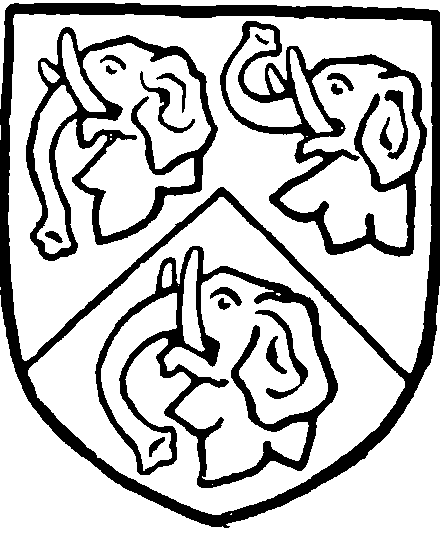
Saunders. Party cheveronwise argent and sable with three elephants' heads razed and countercoloured.
The manor of NETHER SHELTON in this parish was held in 1562 by Sir Thomas Cheyney. (fn. 99) He was succeeded in that year by Henry his son and heir, (fn. 100) who suffered a recovery of it in 1563. (fn. 101) In that year the manor was conveyed to William Clarke, (fn. 102) who in 1565 conveyed it to William Bourne. (fn. 103) John Bourne alienated the manor in 1595 to John Mathers, (fn. 104) who still held it in 1605. (fn. 105) By 1608 it was the property of Thomas Barbor alias Grigge, (fn. 106) who still continued to hold it in 1622. (fn. 107) Within the next fifty years the Griggs had left the county, (fn. 108) and by 1743 William Pryor had become seised of the manor. In this year he conveyed it to Robert Crichton for £560. (fn. 109) In 1792 it was the property of John Foster, (fn. 110) who still held it in 1811. (fn. 111)
The manor of MARSTON or MANGEHOO in this parish appears in the 16th century in the family of Dyve, (fn. 112) who held it as of the manor of Marston Moretaine. John Dyve died seised of it in 1537–8, (fn. 113) and the family continued to hold (fn. 114) until Lewis Dyve transferred it to Robert Odell in 1553 (fn. 115) in exchange for Bromham Manor, and five years later Thomas Odell was in possession. (fn. 116) By 1569, however, it had been transferred to Henry Edward, (fn. 117) who still held it in 1588. (fn. 118) In 1613 he died, and his son Henry inherited it. (fn. 119) There were at this time in the manor three closes besides one which was called Ashelden Close and had an area of 20 acres. The former three closes were held of Thomas Grigge as of his manor of Shelton in Marston Moretaine, and were worth 20s. per annum. Ashelden Close, which was composed of three smaller closes, was parcel of the manor of Shelton, and held of the king as of his manor of East Greenwich, with a value of 3s. 4d. per annum. (fn. 120)
By the middle of the 17th century Mangehoo had become divided amongst six co-heirs, of whom Thomas Dier or Devotion held one share, (fn. 121) John Pryor another (fn. 122) and Thomas Bird another. (fn. 123) In 1657 Alice Rogers was seised of another of such parts. (fn. 124) Two years later, however, she had acquired the inheritance of Thomas Bird, (fn. 125) and although she had not become possessed of the property of all the other four co-heirs, (fn. 126) yet in this year, 1659, she made good her claim to the whole manor of Mangehoo. (fn. 127) Nothing further can be found relating to the history of this manor after 1782, in which year John Pemberton suffered a recovery of it. (fn. 128)
Yet another manor is found within this parish, that of BEANCROFT or BAYNCROFT. There are only two documents from which material for its descent can be derived, and both of these are dated in the 17th century. In 1631 William Gostwick, a younger son of Sir William Gostwick (fn. 129) (who had held lands in Marston Moretaine in 1595 (fn. 130) ), inherited the manor, (fn. 131) and still held it twenty years later. (fn. 132)
Beancrofte Farm, which at the present day marks the site of this manor, is in the tenancy of James Cook. Traces of the old manor-house exist in the large moat which surrounds the present building.
The family of Morteyn acquired early the right of free warren (fn. 133) (1293), and at the beginning of the next century (1324) they were granted a special right of holding a market every Tuesday, besides a yearly fair which was to be held on the vigil, feast and morrow of the Nativity of St. Mary, (fn. 134) to whom the parish church is dedicated. There is no trace, however, of these markets or fairs in this parish subsequent to the 14th century.
CHURCH
The church of ST. MARY THE VIRGIN consists of a chancel 37 ft. 2 in. by 19 ft. 9 in., with north vestry and south chapel, a nave 64½ ft. by 19½ ft., north aisle 9 ft. 9 in. wide, south aisle 8 ft. 4 in. wide and a detached tower 15½ ft. square, situated about 70 ft. away from the north wall of the chancel.
The chancel, vestry and tower date from c. 1340, but all the rest of the church was rebuilt in the 15th century and the chancel remodelled. This work was begun by Thomas Reynes, who died in 1451, and continued after his death, the last work being the north porch, which is an addition not intended in the original design. The evidence shows that the south porch was at first the principal entrance, the old village lying to the south of the church; but the site of the village having been moved to the north, as it is at present, the north doorway became the most used entrance, and a porch was therefore added to it.
The chancel is built of ironstone rubble with an embattled parapet and plinth; the walls are of the 14th century, but the east window and all the others except one on the north belong to the 15th-century remodelling. The east window has five cinquefoiled lights, and on its external labels are shields, one bearing a cheveron between three swans, the other checky, impaling a cheveron between three leopards' heads.
In the north wall, west of the vestry, are two windows, the first of two lights, part of the 14th-century work, and the other a three-light 15th-century window. The north doorway is of 14th-century date, of two continuous pointed moulded orders. On the south of the chancel are two three-light 15th-century windows, and a piscina recess having a square head over a four-centred arch, whilst further west are two squints from the south chapel, and at the south-west a four-centred arch opening to the chapel. The chancel arch is in two moulded orders separated by a casement, and springs from jambs with late 15th-century capitals and bases; on the north side of the arch is a rood stair continuing up on to the roof, the doorways opening towards the nave, on which side also are two four-centred recesses for the nave altars. On the gable above is a sanctus bell-cot.
The vestry is an extremely interesting two-story building, the lower story having a stone rib-vault in two bays. It has a door to the chancel at the southwest, and to the east of the door a narrow window giving a view of the altar. In the north wall are a narrow square-headed window and an arched locker with a rebate for the door; in the east wall is a modern two-light window, and near it in the south wall a piscina. In the south-west angle of the vestry is a stair turret leading to the upper room, which has small trefoiled windows on the east and north, and a fireplace in the north-east angle. On the south wall are three arched recesses, the responds between the two eastern ones being cut back, and in the third is a small rectangular recess with a round hole in the sill, which is carried down in the wall through the head of the doorway which opens to the chancel. In either side of the recess are holes for the end of a beam, to which a wheel or pulley was doubtless fastened, for raising and lowering something in the hole. It is a most curious and interesting feature. The chimney shaft of the fireplace is a modern copy, a very well designed example.
The nave arcades are of five bays, with a narrower sixth bay at the west, and there are five three-light clearstory windows on each side. There is a fine west doorway, now blocked, and over it is a large five-light window, much restored. The nave roof is contemporary with the walls, and has remains of colour in its carved bosses and the figures of angels at the wall plate.
The north aisle has an east window of three cinquefoiled lights, to the south of which is an image bracket and, in the south wall, a very small piscina; the adjacent window in the north wall is similar, and near it is a recess with traces of colour decoration, and an inscription on the sill of which 'anno regni regis Henrici septimi' is still legible, whilst there is a small moulded image bracket to the east of it. The recess doubtless held a group of sculpture, perhaps of alabaster. The north doorway is richly moulded, with a square head and a four-centred arch, and to the west of it is a window similar to that in the east wall; on the east side of the doorway is a four-light cinquefoiled window with tracery under a square head and jambs moulded like the others, and in the west wall is one of the same type but of two lights. The north porch, which, as already noted, was built some years later than the aisle and has a plinth of different section, is finished with an embattled parapet with crocketed pinnacles and has a three-light east window.
The windows and doorway of the south aisle are like those opposite, but on the labels of the doorway are two shields, the one of Reynes, the other of Broughton; in the arch spandrels are two more shields, a cheveron between three leopards' heads for Frowyke, and three running greyhounds for Mauleverer. The porch is contemporary with the aisle. In the south-east angle of the south chapel is an image corbel, and between the first two windows of the south aisle are two aumbries and a moulded image niche, whilst there is another small square recess to the west of the doorway. There is a sundial cut on one of the buttresses to the east of the porch.
The tower is a fine massive building, with diagonal buttresses and a stairway in the thickness of the wall at the north-west angle; the ground stage has a stone rib vault with a bellway, and is entered from the west and lighted by three high-set and narrow windows with flat sills. In the second stage is a large pointed opening, unmoulded and without a rebate for a door, on the south side, looking towards the church, and perhaps originally reached by an outer stair. There are three trefoiled windows in this stage, and a wooden windlass for the bells. The top story is embattled and has a two-light window on each side; these have now lost their mullions. The date of the tower appears to be about the middle of the 14th century.
The 15th-century font stands in one of the bays of the north arcade and has an octagonal panelled bowl on a modern stem. In the north aisle, and commanded by the south doorway, is a painting of St. Christopher, a further evidence that the south door was at first the principal entrance to the church: over the chancel arch is a much defaced Doom, and to the south of the east window of the chancel are other traces of painting. There are a few fragments of old glass in the east window of the north aisle. Part of the rood screen, consisting of four lower panels, with restored paintings of David, Isaiah, Daniel and Hosea, separates the chancel from the nave. At the west end of the chapel is a second screen, and some linen and tracery panels are worked into the pews; these date from c. 1500, and the door between the chancel and aisle is of the same period.
In the floor to the north of the communion table are the brasses of Thomas Reynes, 1451, and his wife Elizabeth, with their nine children. There are two shields: (1) the cheveron and leopards' heads of Frowyke, and (2) the quarterly coat of Reynes, showing Reynes quartered with Frowyke, the hounds of Mauleverer and a chief indented. To the south of the communion table is the brass of Walter Papley, rector, 1420, and near it that of Mary Leutton, late wife of Thomas Reynes, 1506, with two shields: (1) Checky a canton ermine, impaling a cheveron between three molets, and (2) A bend impaling checky a canton. There are several floorslabs to the Snagge family; Thomas and his wife Anna 1642 and 1657, with the arms of Snagge, quartering Decons and Reynes; Thomas, 1687; Edward, 1715; and on the chancel wall a monument to Thomas Snagge, 1698, with Snagge impaling Nicholls. In the chapel are an altar tomb, c. 1520, without brasses and heraldry, and a late 16th-century alabaster tomb, with recumbent effigies of Serjeant Thomas Snagge and Elizabeth Decons his wife under a canopy supported by Ionic columns; on the wall behind are carved figures in low relief of five sons and two daughters, and on the base are (1) the arms of Snagge; (2) Decons and Reynes quarterly; and (3) the same coats impaled. On the north wall of the chapel is painted the quarterly coat as above, impaling a second quarterly coat; (1) Rotheram; (2) Snagge; (3) a bend sinister between three martlets; (4) a mailed arm and fist holding a javelin.
There are five bells, all alphabet bells of 1610, by Hugh Watts of Leicester.
The plate consists of a cup with date letter 1614 having a cover paten, and another of the same date without cover, a large foot paten presented in 1806 and an electro-plated flagon.
There are five books of registers previous to 1812, containing (1) all entries 1653 to 1669 and burials and marriages to 1690; (2) all entries 1703 to 1751; (3) baptisms and marriages 1752 to 1812; (4) marriages 1754 to 1785, and (5) marriages 1785 to 1812.
ADVOWSON
The descent of the advowson follows that of the manor of Marston (q.v.) from the time of Walter and Robert de Wotton through the families of Morteyn, Reynes, Decons and Snagge till 1682. In that year it was the property of John Rotherham, (fn. 135) who had married Agnes daughter of Thomas Snagge. (fn. 136) This was probably only a life interest, however, as by 1708 the advowson was again in the hands of the Snagges, (fn. 137) until in 1746 George Stead, goldsmith, had acquired it. (fn. 138) In 1795 it was the property of St. John's College, (fn. 139) Cambridge, in whose possession it remains at the present day.
John Hermer, who was a joint feoffee with Bernard de Willey in the manor of Wroxhill (fn. 140) (q.v.), was seised in 1286–7 of 'the advowson of the church of Wroxhill.' (fn. 141) This church was probably a chapel of ease to Marston parish church, for in 1460 we find that William Saunderton, lord of the manor, released to the parson of the church all claim against him concerning finding a private chaplain for three days a week in the chapel of St. Lawrence the Martyr near the site of the said manor. (fn. 142) Lysons also mentions the chapel as having once existed; but it had ceased to be used by his day. (fn. 143)
CHARITIES
The Charity Estates, the particulars of the acquisition of which are unknown, are regulated by a scheme of the Charity Commissioners of 7 June 1904. They comprise:—
The Caulcott Charity Land, consisting of 4 a. 1 r. 24 p. at Wootton and 3 a. 1 r. 15 p. in the parish, rental value £11.
The Apprenticing Charity, consisting of 15 acres at Caulcott, a messuage and 3 roods at Upper Shelton and £218 4s. 6d. consols, income £40 or thereabouts.
The Widows' Land, consisting of 3 a. 2 r. at Caulcott and £403 1s. 5d. consols, income £15 10s.
Charity of Rev. Maurice Farrell, will, 30 January 1888, trust fund £100 consols, income £2 10s.
The several sums of stock are held by the official trustees, arising, with the exception of the last-mentioned, from sales of land.
By the scheme above referred to, varying previous schemes, the income of these charities, after applying one-half of the Apprenticing Charity in apprenticing and the other half of the same charity in the maintenance of exhibitions, not exceeding £10 yearly, tenable at a secondary school, is made applicable in subscriptions in aid of any dispensary, hospital or convalescent home, provision of nurses, cost of outfit, and in the supply of clothes and other necessaries to an amount not exceeding £15 in any year.
The official trustees also hold a sum of £33 12s. 6d. consols, arising from commutation of rent-charge of £1 secured upon the Magpie Hall Farm, the property of the Duke of Bedford, the income of which is distributed to the poor of Marston Pillinge.
The official trustees also hold £125 5s. 2d. consols, the share of this parish in the charity of John Bryan (will, 1655), the income of which, amounting to £3 2s. 8d., is distributed in bread amongst the poorest people.
In 1835 William Howe by his will, proved in the P.C.C., bequeathed £200, the income to be distributed in Christmas week amongst honest and industrious poor at Lower Shelton. The legacy is represented by £211 5s. 7d. consols, with the official trustees, the annual dividends of which, amounting to £5 5s. 8d., are duly applied.
The Wesleyan Methodist chapel, comprised in indenture of 1819, is regulated by a scheme of the Charity Commissioners, 1871.